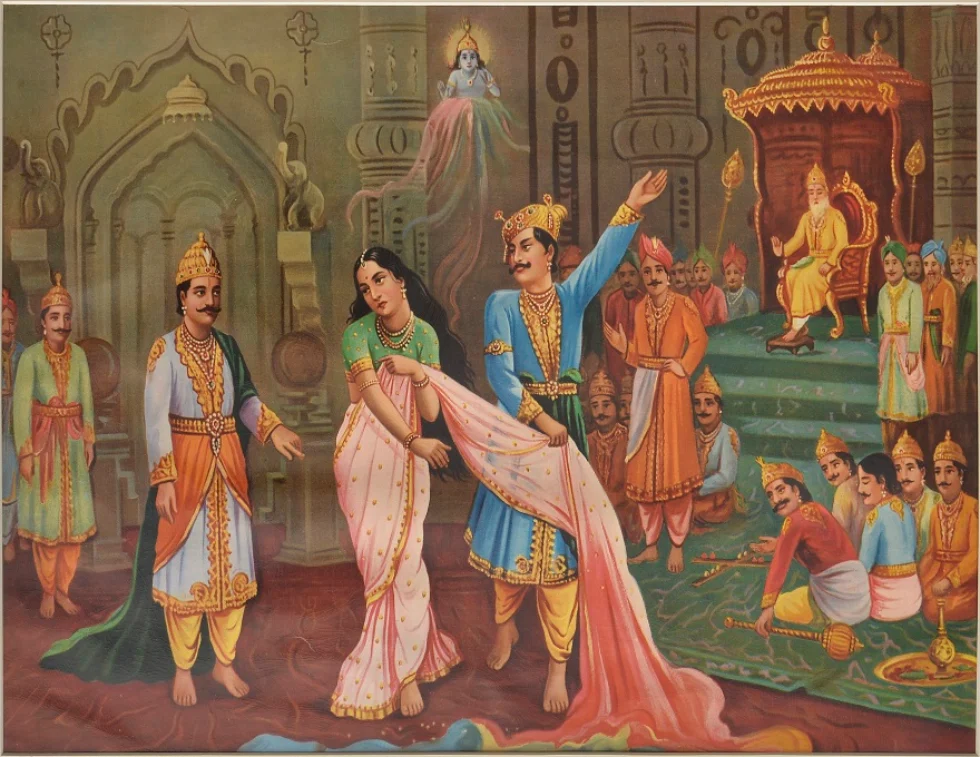The Mahabharata utterly baffled me as an innocent six-year-old. My mother had gifted me a (thankfully abridged) version of the Hindu epic for my birthday. It taunted me with baleful snippets of unrevealing information. Abloom with brightly colored childish illustrations of the bloodiest battles, the book gave me sleepless nights for the next two years. From the storybooks I passed on to the passionate yet unexaggerated retellings of my grandparents and then to my favorite — the Amar Chitra Katha comics.
When I was eight, I was drawn to the Mahabharata TV show by BR Chropa. My parents loved watching the show, but it sent eight-year-old me either sobbing to my room or gasping in wonder more times than I can count. Flashes of quivering mustaches and fiery red saris encrusted with jewels haunted my nightmares. Oceans of tears gushing down porcelain faces, accompanied by blaring trumpets and angry crescendos, elicited emotions I had never experienced before.
Even in those early years, I found myself constantly analyzing the roles played by the characters in the infinite versions I saw. From Duryodhana to Yudhisthira, I believe it’s worth it to examine the course of the characters’ lives and the extent to which their own misgivings and flaws led to their eventual demises. Draupadi, the main female protagonist, fascinated me in particular: time and again, the actions of the men and women in her life affected her greatly, yet she still remained strong-willed and steadfast.
One particularly interesting source I will consider is The Palace of Illusions by Chitra Banerjee Divakaruni, a chronicle of the life of Draupadi in the first person. Accordingly, I’ll also be focusing primarily on Draupadi as an individual.
Everything begins with a fateful game of dice
In the serial Mahabharata, I could only watch Draupadi’s cheerharan, or undressing, through the gaps in my fingers. It utterly discomfited me as a child. A single piece of cloth clings to the dips of a woman’s body as she stands in a royal hall. Her hair is tight in the grasp of a man, and he reaches in glee to disrobe her for all to witness. Some of the men in the room watch with enjoyment. Others watch with helplessness. Though surrounded, the woman is utterly alone.
Just as Draupadi is on the precarious edge of losing her womanly dignity, she ends up preserving it by the grace of Lord Krishna. Krishna thwarts the men by blessing her garment to remain endlessly long. Ultimately, Draupadi escapes humiliation, but the scene makes one think of how it could have been prevented in the first place. Who was truly at fault for setting it into motion? Let’s rewind a little and examine the scene, like my own parents often did during the particularly dramatic moments.
The ordeal begins with a succession crisis, a warring family and a fateful game of dice. The ancient kingdom of Kuru had been split down the middle. One half had gone to the Pandavas, a group of five brothers, and the other half had gone to the Kauravas, their cousins. Originally, the father of the Pandavas, Pandu, had been king of Kuru. His older brother Dhritarashtra, father of the Kauravas, had given up his birthright due to his blindness. However, an incident with a rishi, or sage, left Pandu humiliated and exiled. Dhritarashtra regained the throne. To avoid a succession crisis between Dhritarashtra, the Kauvaras and the Pandavas, the kingdom of Kuru was split down the middle.
Duryodhana, eldest son of the Kauvaras, grew angry at the perceived unfairness. His maternal uncle Shakuni urged the Kauvaras to take advantage of Yudhisthira, the eldest Pandava son, and his gambling addiction. Several sources assert that wily uncle Shakuni possessed a pair of magical dice. Initially, Yudhisthira was on a winning streak, but his euphoria fueled his greed for more. That’s when things went downhill. With Shakuni’s help, the Kauravas won game after game and Yudhisthira lost and lost. His palace, the lives of Pandavas, the clothes on their backs were all gambled away, but he never stopped playing. Eventually they had nothing to their names — not even Draupadi, wife to all five Pandavas, who Yudhisthira had bet and lost. Eventually he had to gamble off their wife too, and the rest, as they say, is history.
Now — who was at fault for this taking place? Let’s first look at Yudhisthira. Son of Kunti, demigod, with an undying belief in dharma (moral behavior and duty) and a passionate love of truth. Son of Yama, mild, with a crippling gambling addiction. Although it was Yudhisthira’s fatal habit that brought about the incident, that is not to say Yudhisthira gets off scot-free. There are other aspects of his person to be considered. How contradictory, how hypocritical, it was of this “moral” man to gamble off his entire life before his and his family’s eyes? His initial winnings spurred him to continue playing out of arrogance. For an upholder of dharma and a believer in justice, who is he to deal off his entire family? Out of arrogance? He treats his own brothers — and even himself — as objects, exchanged in the blink of an eye in the game of die. But there is no one he considers an object more than Draupadi.
To her husbands, Draupadi is property
Draupadi is a woman divided among five men. This polyandry may appear better off for her — she gets five husbands — but at the end of the day, she isn’t able to wholly love one man of her dreams. This is wonderfully elucidated in The Palace of Illusions, which states, like many sources, that she was actually in love with a man named Karna. Draupadi, like piecemeal, is fragmented, divided to be shared by her five husbands. Let’s not forget that she could only enjoy each man as her husband for one year until his turn came again. Most importantly, each husband took more wives for himself. She was simply the one common wife.
Even after serving as a dutiful wife, even after accepting that she might never truly have one loving husband who would devote himself entirely to her, the helpless Draupadi was gambled away by Yudhisthira. Was she truly his to gamble? Did he treat her as a husband should a wife? Sure, he regarded her with due respect. But she wasn’t — in the true sense of the word, in every sense of the word — his. Draupadi, considered one of the paragons in the Hindu feminist mythological narrative, was pawned off like she was nothing. Keep in mind that this is done by the same great upholder of dharma.
One fascinating point to note is that Yudhisthira had already gambled himself and his brothers away. They did not “own” themselves. Now, this leads one to believe that since they owned nothing now, not even themselves, they did not own Draupadi. Was it truly right for him to gamble away his wife, who he did not own now?
What is perhaps even more shameful is his brothers’ passive reactions to the whole incident. Their sense of duty and respect toward their brother outweighed the need to defend their wife’s honor. The Pandavas could have easily prevented their brother from making this lapse in judgment, but they were bound by their perceived dharma. Then what truly is dharma? Is righteousness truly obedience and passivity in the face of wrongdoing, or is it standing up for the defenseless? Their behavior begs the answer to the question of which holds more value in society.
Who is truly at fault?
Some scholars suggest it was Draupadi herself that set things into motion. According to several sources, when the Kauravas visited Indraprastha’s famed Palace of Illusions, Duryodhana mistook a glossy river for a slab of glass due to its unmoving stillness. After attempting to walk on the “glass” and subsequently falling, allegedly Draupadi couldn’t hold in her mirth and exclaimed, “The blind man’s son is also blind.” A mortified Duryodhana vowed for revenge. However, according to Divakaruni’s book, it wasn’t Draupadi who laughed and made this statement but a handmaid of hers. Draupadi had simply smiled, but Duryodhana misconstrued the situation and assumed it was Draupadi, seeing her through her window watching him.
Her smile or laugh may have been a deliberate act of defiance, reflecting her strong-willed nature. Duryodhana took this as her mocking him — something his ego simply could not handle — and this exacerbated already rising hostilities between the two sides. While Draupadi’s laughter is a notable incident, it is by no means an excuse to justify Duryodhana’s acts during the vastraharan. It’s important to understand that Draupadi, too, is human, and thus displays human emotion — her lighthearted laughter reflects her strong will; it may have been a moment of relief or defiance for her during a time of high tensions.
The women turned a blind eye
Draupadi isn’t the only woman who has agency — or lack thereof — in the story. Gandhari, mother of the Kauravas, is one who, in my opinion, isn’t talked about enough in the context of this incident. She’s regarded as a woman who isn’t afraid to undergo harsh physical torment to attain what she wants. According to legend, she underwent severe penance to attain a boon from Lord Shiva, who granted her the blessing of being mother to a hundred sons. (This raises questions of where the value of a woman truly lay in those times if a hundred sons was considered a boon, but that is a discussion for another time.)
A devout woman, she was married off to Dhritarashtra, older brother of Pandu and the blind prince of Hastinapur. In an act of solidarity and devotion she blindfolded herself so that she may live like her husband. This act has been widely debated by scholars, some stating that this was to rebel against her father and the Kuru dynasty for pawning her off to a blind man. The question now arises; why does Gandhari hide from reality? The act of blindfolding herself is an inherent abdication from responsibility. Instead of navigating the challenges of being married to a blind man, she retreats from the world and paralyzes herself.
Some argue that true support for her husband would be to guide him and provide strength in areas he lacked. However much it can be argued that she was simply adopting the moral high ground, she has been proven to be a selfish woman by supporting her sons’ cruel ambitions.
Gandhari could have utilized her sight to participate actively in her children’s lives and court activities, but she quite literally turns a “blind eye” to their actions. Being the mother of the Kauravas, it was Gandhari’s duty to instill in them values of respect for all and justice. It was her duty to identify the misgivings of Duryodhana and his moral and ethical lapses. His lack of a participating, seeing maternal figure may have contributed to his cruel disposition.
Moreover, she could have guided her disabled husband and exerted her authority as queen mother to stop the gambling match. It was her duty as the wife of a monarch to assist him in upholding dharma. Her inaction in the face of her son’s scheming against the Pandavas can be seen as a form of tacit complicity. She made no efforts to prevent his plans from escalating. As already underscored, she symbolically and literally blindfolded herself to remove herself from any blame and refuse to acknowledge the harsh injustices happening under her watch.
The scrutiny of maternal figures wouldn’t be comprehensive without a look at Kunti, mother of the Pandavas. Kunti was the firstborn of Yadava ruler Shurasena and was given to her father’s childless cousin Kuntibhoja at birth due to a promise made earlier. She, not unlike Gandhari, gained a boon (through her hospitable treatment of a sage), to summon a celestial being at will to beget children.
She begot her first and eldest son Karna through the impetuous satiation of this boon while she was still a virgin. The father of Karna was Surya, the sun god. Kunti, who was just testing out her boon, begged him to go back, but nothing could be done. And the son of the sun was born.
To untether herself from her newborn child, Kunti made a decision that would affect the years to come in ways unimaginable. She abandoned him on the Ganga.
The men encouraged malicious behavior
The unknowing Karna, adopted by a poor charioteer, grew up to become one of Duryodhana’s staunchest allies. As the Kauravas’ ally, he became one of the Pandavas’ deadliest foes, and strengthened the Kauravas’ military position. Kunti’s deep-rooted efforts to keep her eldest son’s lineage a secret only bolstered the hostility between the Pandavas and the Kauravas and increased familial discord.
Furthermore, Karna grew insecure of his ostensibly poor lineage due to the subsequent discrimination he would face. The most obvious evidence of this is shown in Draupadi’s swayamvar, or presentation of suitors, where he was not allowed to participate due to his lack of status. This injustice compounded his yearning for recognition, which in turn contributed to his future decisions and persona. All of this because Kunti refused to face her mistake.
Karna’s insecurity and subsequent hatred of Draupadi due to his humiliation at the swayamvar may have contributed to his inaction during the proceedings. He was an active perpetrator at the vastraharan — the disrobing — directly contributing to it by demeaning Draupadi and encouraging Duryodhana. He humiliated her by calling her a “whore” for being wedded to five men. Karna’s argument was that since Draupadi now belonged to the Kauravas, she had no rights, no dignity, and her disrobing was justified. This point becomes especially controversial when viewed through the lens of Divakaruni’s Palace of Illusions, where it is stated that Draupadi and Karna loved each other. How, then, was this an act of love? His mortification is justifiable, but his action was not. Draupadi continued to love him in the book, even after this incident. Was this heinous act of disrespect really forgivable?
Karna had the power to stop the violence. Duryodhana paid rapt attention to Karna’s every word according to most sources and this book as well. Had Karna made efforts to stop the act, the whole incident could have been avoided. The escalation of the conflict and the resultant Great War itself could have been a possibility.
Inaction from others aside, Duryodhana and Dushasana were the most obvious perpetrators in committing the shameful act. Duryodhana commanded for Draupadi to be brought to the court for her public humiliation. Draupadi was, at the time, going through her menstrual cycle, during which she was a Rajaswala, a menstruating woman, and had to wear a single garment.
In Dushasana, I sometimes think that true evil is manifest. He is a symbol of the darker shadowed regions of the Kaurava clan — representing greed, envy, aggression and an utter disregard for justice. He callously slapped Draupadi and dragged her by the hair even as she protested, showing no remorse for his actions and gleefully reveling in her mortification. Duryodhana proceeded to verbally abuse and demean Draupadi in court along with his brothers. Warnings from the older and wiser courtiers like Vidura and Bhishma fell on deaf ears as he insisted on her disrobing. Where was dharma in all this?
The elders of the Kaurava court are also to blame. Dhritarashtra, the father; and Bhishma and Vidura, both family members; are not as helpless as they seem. Bhishma Pitamaha is supposed to be a beacon of wisdom and authority. Why, then, did he not stop the vastraharan? Dhritarashtra may have been crippled but he was certainly not powerless. His weakness in yielding to Shakuni’s manipulation and his son’s follies cannot be ignored. Vidura, as an elder, could have provided more forceful counsel to Duryodhana and ordered him to stop.
With so many key figures contributing to the vastraharan, it is difficult to determine whether it would still have taken place under different circumstances. Duryodhana’s deep-seated animosity, Shakuni’s orchestration, the lack of intervention and above all perhaps some divine will all played their own parts in instigating the incident, and many, to different extents, are to blame.
The views expressed in this article are the author’s own and do not necessarily reflect Fair Observer’s editorial policy.


























































































































































































You must be logged in to post a comment Login